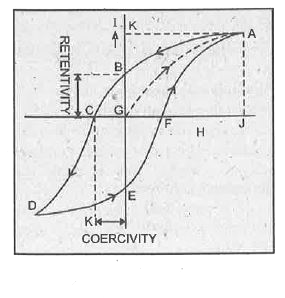Define the term retentivity and coercivity.
Video Solution
Text Solution
When an iron or steel rod is subjected to a cycle of magnetisation, we get a curve as shown in the figure.

When magnetising field is maximum i.e. GJ the intensity GK is also maximum. When strength of the field is reduced to zero the intensity is not zero. It is still GB i.e., some magnetisation is left or retained.
The value of intensity of magnetisation of a material, when the magnetising field is reduced to zero is called retentivity or residual magnetism of the material.
When the strength of magnetic field is increased in the reverse direction, the intensity of magnetisation becomes zero at C. To reduce the magnetic of magnetisation becomes zero at C. To reduce the magnetic field to zero, we have to apply a magnetising field GC in the opposite direction. This magnetic field is called coercivity of the material.
The value of reverse magnetising field which is to be applied to the magnetic material so as to reduce the residual magnetism to zero is called coercivity of the material.
|
Topper's Solved these Questions
- MAGNETISMBOOK - MBD -HARYANA BOARDCHAPTER - MAGNETISMEXERCISE - SHORT ANSWER TYPE QUESTIONS
4 Videos
- MAGNETISMBOOK - MBD -HARYANA BOARDCHAPTER - MAGNETISMEXERCISE - LONG ANSWER TYPE QUESTIONS
7 Videos
- ELECTROSTATICSBOOK - MBD -HARYANA BOARDCHAPTER - ELECTROSTATICSEXERCISE - OBJECTIVE TYPE QUESTIONS
23 Videos
- MODEL TEST PAPER (SOLVED)BOOK - MBD -HARYANA BOARDCHAPTER - MODEL TEST PAPER (SOLVED)EXERCISE - LONG ANSWER TYPE QUESTIONS
6 Videos
Similar Questions
Knowledge Check
For a permanent magnet the properties retentivity and coercivity are respecitively
Ahigh -lowBlow-highChigh-highDlow-lowThe hysteresis curve for a material is shown in the figure. Then for the material retentivity, coercivity and saturation magnetization respectively will be
 A50 A/m, 1T, 1.5 TB1.5 T, 50 A/m, 1TC1 T, 50 A/m, 1.5 TD50 A/m, 1.5 T, 1 T
A50 A/m, 1T, 1.5 TB1.5 T, 50 A/m, 1TC1 T, 50 A/m, 1.5 TD50 A/m, 1.5 T, 1 T
